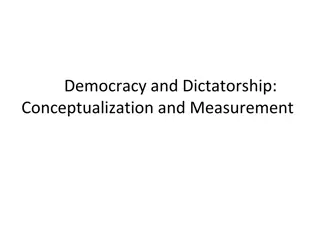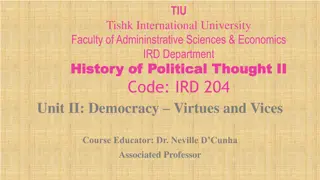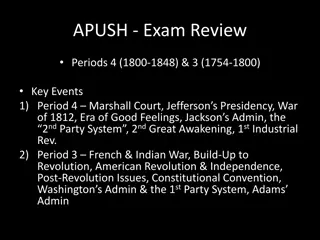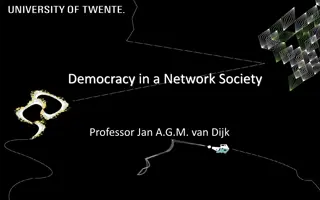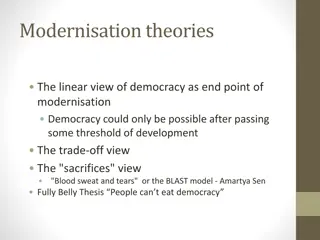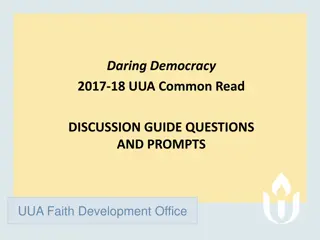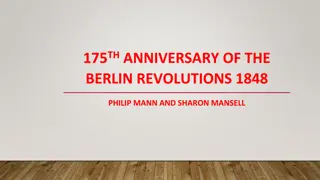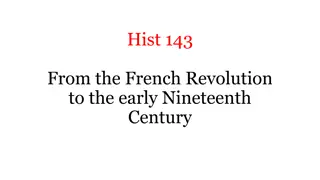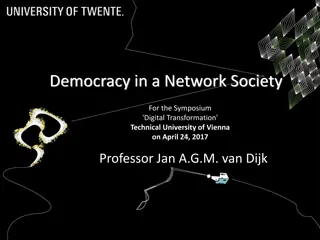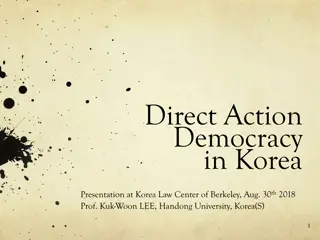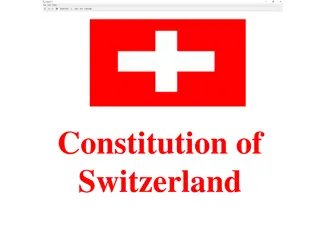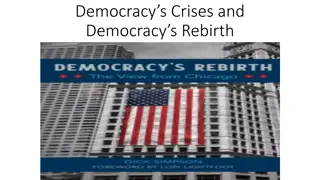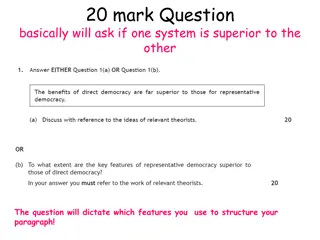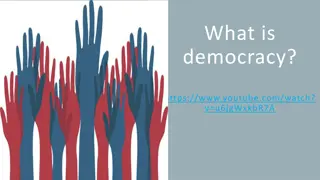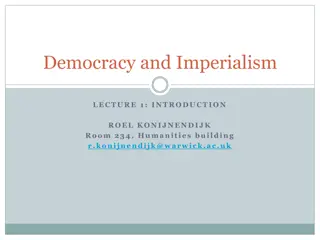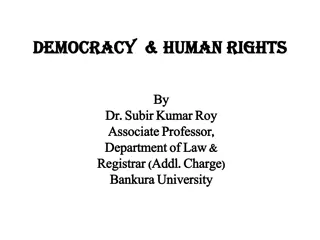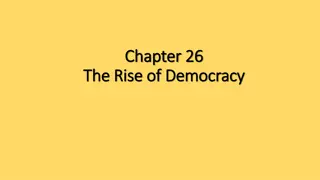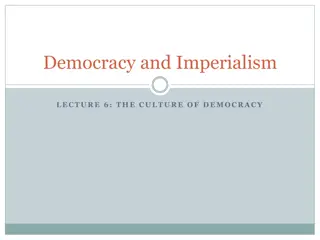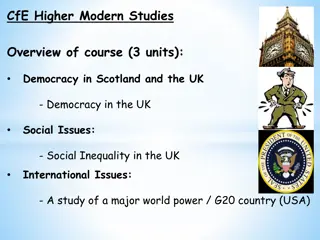Key Concept 4.1: Transition to Modern Democracy and National Culture in 1800-1848
The United States underwent a transformative period from 1800 to 1848, embracing modern democracy and a new national culture. This era saw the rise of political parties, such as the Federalists and Democratic-Republicans, as well as significant judicial decisions that shaped federal power. Additionally, the Second Great Awakening influenced societal changes, including the development of distinctive cultures and the emergence of reform movements. Explore the key concepts and events that defined this crucial period in American history.
Download Presentation

Please find below an Image/Link to download the presentation.
The content on the website is provided AS IS for your information and personal use only. It may not be sold, licensed, or shared on other websites without obtaining consent from the author. Download presentation by click this link. If you encounter any issues during the download, it is possible that the publisher has removed the file from their server.
E N D
Presentation Transcript
www.Apushreview.com Period 4: 1800 1848 Shout-outs to Mr. Sommer s Class in FL, Mr. Bannister s Class and Mr. Barne s APUSH Review: Key Concept 4.1 Class. Thank you all for the support! Everything You Need To Know About Key Concept 4.1 To Succeed In APUSH Updated for the 2015 revisions
The New Curriculum Key Concept 4.1 The United States began to develop a modern democracy and celebrated a new national culture, while Americans sought to define the nation s democratic ideals and change their society and institutions to match them. o Page 44 of the Curriculum Framework Big ideas: o What were the reasons for the development of political parties, and characteristics of each party? o How did the Second Great Awakening impact America? o How did slaves adapt to their circumstances and create a new culture?
Key Concept 4.1 I The nation s transition to a more participatory democracy was achieved by expanding suffrage from a system based on property ownership to one based on voting by all adult white men, and it was accompanied by the growth of political parties. page 44 of the curriculum framework A. Political Parties in the early 1800s (Federalists and Jeffersonians) o Federalists: favored stronger central government, supported by upper-class, merchants and bankers, and Pro-British, loose interpretation of the Constitution o Democratic-Republicans: states-rights, supporter by lower and middle classes, farmers, Pro-French, strict interpretation of the Constitution Both parties developed out of Hamilton s Financial Plan and the French Revolution B. The Supreme Court strengthened the power of the federal government, often at the expense of state governments: o Marbury v. Madison established the principle of judicial review o McCulloch v. Maryland upheld constitutionality of 2nd BUS, federal government given more power of states o Gibbons v. Ogden Congress, NOT states can control interstate commerce
Key Concept 4.1 I C. Democrats and Whigs o Democrats: Led by Andrew Jackson, the Common Man : against BUS and the American System o Whigs: (Henry Clay!) Anti-Andrew Jackson; favored stronger federal government, internal improvements, tariffs, and the BUS D. Regional political and economic loyalties overshadowed national concerns: Nullification Crisis (1833) South Carolina and other southern states opposed the Tariffs of 1828 and 1832; South Carolina even nullified those tariffs South Carolina threatened to secede if Jackson collected the tariff by force Webster s 2nd Reply to Hayne Webster promoted nationalism over sectionalism
Key Concept 4.1 II While Americans embraced a new national culture, various groups developed distinctive cultures of their own. page 45 of the curriculum framework A. The 2nd Great Awakening sought to inspire humans to achieve perfection: o Charles G. Finney massive sermons to convert individuals o Utopian Societies social experiments that hoped to achieve perfection in communities Oneidas, Brooke Farm, etc. o Inspired other reform movements: Temperance, Abolitionism B. The emergence of a new national culture o Was a combination of European and local culture o New American Art, literature, and architectural ideas emerged Examples: John James Audubon made significant contributions to the study of birds prints of birds The Hudson River School focused on landscape paintings; believed nature was a great source of wisdom and inspiration
Key Concept 4.1 II C. Literature, art, philosophy, and architecture reflected a belief in human perfectibility o Transcendentalism 1830s movement that encouraged individuals to have communication with God and nature o Ralph Waldo Emerson Self-Reliance individuals should follow self interests o Henry David Thoreau Walden, Civil Disobedience D. Enslaved African Americans created communities and sought to protect their family structures and dignity o African Americans developed surrogate families o When families were separated via slavery, others would look after family members o Slave music used to help pass the time while working Instrumental part of religious services
Key Concept 4.1 III Increasing numbers of Americans, many inspired by new religious and intellectual movements, worked primarily outside of government institutions to advance their ideals. page 46 of the curriculum framework A. Organizations that attempted to improve society and individual behavior o American Temperance Society: Co-founded by Lyman Beecher (Harriet Beecher-Stowe s father) Created 1,000s of chapters throughout the US Aligned with the abolitionist movement o Dorothea Dix sought to improve treatment for the mentally ill o Horace Mann Father of Education o Shakers - practiced celibacy,; believed in sexual equality
Key Concept 4.1 III B. Abolitionist and Anti-Slavery Movements o Achieved success in the North many northern states gradually emancipated slaves o Was an increasing number of free African Americans in the North AND the South: Eventually, many states made it illegal for slave owner to manumit (free) their slaves Antislavery in the South: o Gag-order prohibited the introduction of abolitionist bills in the House of Reps o Unsuccessful rebellions in the South: Denmark Vesey (1820): largest planned rebellion, never materialized o Vesey and followers were hanged -> more strict slave laws Nat Turner s Rebellion (1831): o Rebellion in VA, freed slaves and killed whites on plantations o 100s of blacks killed in retaliation (some of which had nothing to do with rebellion) o Coincided at the same year as William Lloyd Garrison s The Liberator Called for the immediate and uncompensated end to slavery C. Women s Rights Movement: o Often connected to the abolitionist movement o Hoped to achieve greater equality o Seneca Falls Convention: women s rights convention in NY - Elizabeth Cady Stanton and Lucretia Mott Attended by Frederick Douglass
Test Tips Multiple-Choice and Short Answer Questions: o Examples of court cases that increased the power of the federal government o Characteristics of political parties o Organizations and individuals that sought to improve society o Ways slaves resisted their condition Essay Questions: o Issues that led to the creation of political parties o Impact of the 2nd Great Awakening on American society
See You Back Here For Key Concept 4.2! Thanks for watching Please subscribe and share Good luck in May You re brilliant!



